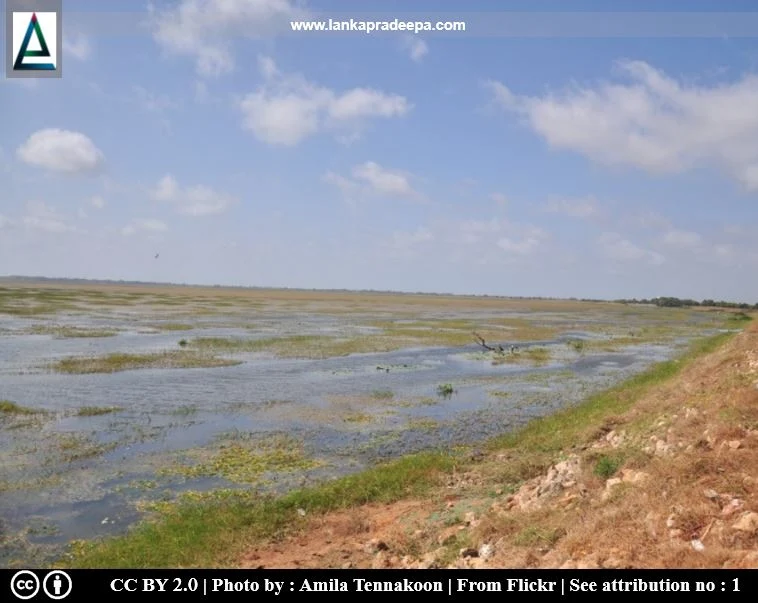
Yodha Wewa (lit: Giant's Tank) is a large irrigation tank situated in Mannar District, Sri Lanka.
History
The tank presently known as Yodha Wewa is believed to be the ancient Manamatta tank mentioned in Mahawamsa (Asanga & Nishantha, 2018; Nicholas, 1963). It was constructed by King Dhatusena (455-473 A.D.) and restored in the 12 century by King Parakramabahu I [(1153-1186 A.D.) Asanga & Nishantha, 2018; Nicholas, 1963]. However, some scholars such as Ranawella in the opinion that the ancient Manamatta tank could be the present reservoir at Periyakulam near Velgam Vehera (Ranawella, 2001).
The Tamil author, Mudaliyar C. Rasanayagam, in his book 'Ancient Jaffna', gives a short description about this tank as follows;
The Tamil author, Mudaliyar C. Rasanayagam, in his book 'Ancient Jaffna', gives a short description about this tank as follows;
The existence of the extensive ruins at Matota and of the celebrated Giant's Tank close to it, are indubitable signs of an immense population well advanced in agriculture. This tank is apparently the most ancient work extant in Ceylon, so ancient that it is not mentioned as having been built by any of the kings who reigned in Ceylon after Vijaya. The Giant's tank must, therefore, have been the work of the remotest times, constructed probably by the ancient Nagas, who were the people then living in that part of Ceylon.Rasanayagam suggests that the tank was probably constructed by the Nagas who are said to be an ancient tribe of Sri Lanka. Nagas are mentioned in several ancient texts such as Mahavamsa and Manimekalai, as a class of superhuman beings who inhabited a subterranean world (Paranavitana, 1961).
Citation: Rasanayagam, 1926
Restoration
The tank was mentioned and reported during the colonial period by several Dutch and British officers such as Van Imhoff, Thomas Maitland, Emerson Tennent, Hercules Robinson, H. Parker, R.L. Brohier etc. (Asanga & Nishantha, 2018). Consideration was given to renovating the tank in 1739 by the Dutch rulers, but it was abandoned due to the lack of labour (Asanga & Nishantha, 2018). A motion which was brought to the State Council in 1889, by P. Ramanathan revived the restoration work of the tank (Arumugam, 1969). The restoration of the tank and the old canal were completed in 1897 (Asanga & Nishantha, 2018).
The tank
The tank is fed by the water that comes from Malwathu Oya. In order to turn the water into the Yodha Wewa, a long stone dam known as
Thekkama Amuna (Tamil: Tekkam) has been built across the
Malwathu Oya. The canal which starts from the Thekkama dam is named Aalawakka-ela.
Source of Supply: Inlet channel (Aalawakka- ela) from the Thekkama Amuna (Malwatu Oya diverted flow)
Catchment area: 38 sq. miles
Length of bund: 4.5 miles
Tank full storage: 26,600 acre ft.
Area of water spread: 4550 acres
No. of sluices: seven
Reference: Arumugam, 1969
Yodha Wewa Sanctuary
The Yodha Wewa Tank and its surrounding area were declared as one of the Sanctuaries in Sri Lanka by the government on 24 September 1954.
 .
.
Attribution
1) Yoda Wewa (Giant’s Tank) by Amila Tennakoon is licensed under CC BY 2.02) Yoda Wewa (Giant’s Tank) by Amila Tennakoon is licensed under CC BY 2.0
References
1) Arumugam, S., 1969. Water resources of Ceylon: its utilisation and development. Water Resources Board. p.333.
2) Asanga, M. V. G. K.; Nishantha, I. P. S., 2018. Mannarama Distrikkaya (In Sinhala). Department of Archaeology (Sri Lanka). ISBN: 978-955-7457-10-9. pp.58-59.
3) Nicholas, C. W., 1963. Historical topography of ancient and medieval Ceylon. Journal of the Ceylon Branch of the Royal Asiatic Society, New Series (Vol VI). Special Number: Colombo. Royal Asiatic Society (Ceylon Branch), p.81.
4) Paranavitana, S., 1961. The Arya kingdom in north Ceylon. JRAS (CB), 7, pp.172-224.
5) Ranawella, S., 2001. Inscription of Ceylon. Volume V, Part I. Department of Archaeology. ISBN: 955-9159-21-6. p.38.
2) Asanga, M. V. G. K.; Nishantha, I. P. S., 2018. Mannarama Distrikkaya (In Sinhala). Department of Archaeology (Sri Lanka). ISBN: 978-955-7457-10-9. pp.58-59.
3) Nicholas, C. W., 1963. Historical topography of ancient and medieval Ceylon. Journal of the Ceylon Branch of the Royal Asiatic Society, New Series (Vol VI). Special Number: Colombo. Royal Asiatic Society (Ceylon Branch), p.81.
4) Paranavitana, S., 1961. The Arya kingdom in north Ceylon. JRAS (CB), 7, pp.172-224.
5) Ranawella, S., 2001. Inscription of Ceylon. Volume V, Part I. Department of Archaeology. ISBN: 955-9159-21-6. p.38.
6) Rasanayagam, C., 1926. Ancient Jaffna: Being a Research Into the History
of Jaffna from Very Early Times to the Portug [u] ese Period. Asian
Educational Services (1984). pp.82-83.
Location Map
This page was last updated on 20 December 2022


